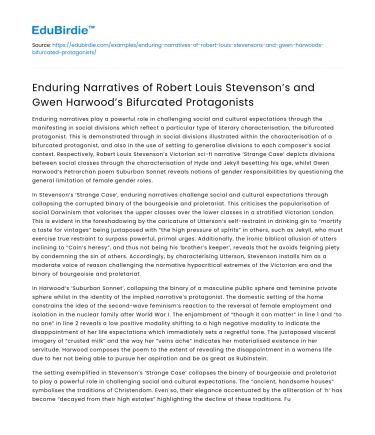Enduring narratives play a powerful role in challenging social and cultural expectations through the manifesting in social divisions which reflect a particular type of literary characterisation, the bifurcated protagonist. This is demonstrated through in social divisions illustrated within the characterisation of a bifurcated protagonist, and also in the use of setting to generalise divisions to each composer’s social context. Respectively, Robert Louis Stevenson’s Victorian sci-fi narrative ‘Strange Case’ depicts divisions between social classes through the characterisation of Hyde and Jekyll besetting his age, whilst Gwen Harwood’s Petrarchan poem Suburban Sonnet reveals notions of gender responsibilities by questioning the general limitation of female gender roles.
In Stevenson’s ‘Strange Case’, enduring narratives challenge social and cultural expectations through collapsing the corrupted binary of the bourgeoisie and proletariat. This criticises the popularisation of social Darwinism that valorises the upper classes over the lower classes in a stratified Victorian London. This is evident in the foreshadowing by the caricature of Utterson’s self-restraint in drinking gin to “mortify a taste for vintages” being juxtaposed with “the high pressure of spirits” in others, such as Jekyll, who must exercise true restraint to surpass powerful, primal urges. Additionally, the ironic biblical allusion of utters inclining to “Cain’s heresy”, and thus not being his ‘brother’s keeper’, reveals that he avoids feigning piety by condemning the sin of others. Accordingly, by characterising Utterson, Stevenson installs him as a moderate voice of reason challenging the normative hypocritical extremes of the Victorian era and the binary of bourgeoisie and proletariat.
Save your time!
We can take care of your essay
- Proper editing and formatting
- Free revision, title page, and bibliography
- Flexible prices and money-back guarantee
In Harwood’s ‘Suburban Sonnet’, collapsing the binary of a masculine public sphere and feminine private sphere whilst in the identity of the implied narrative’s protagonist. The domestic setting of the home constrains the idea of the second-wave feminism’s reaction to the reversal of female employment and isolation in the nuclear family after World War I. The enjambment of “though it can matter” in line 1 and “to no one” in line 2 reveals a low positive modality shifting to a high negative modality to indicate the disappointment of her life expectations which immediately sets a regretful tone. The juxtaposed visceral imagery of “crusted milk” and the way her “veins ache” indicates her materialised existence in her servitude. Harwood composes the poem to the extent of revealing the disappointment in a womens life due to her not being able to pursue her aspiration and be as great as Rubinstein.
The setting exemplified in Stevenson’s ‘Strange Case’ collapses the binary of bourgeoisie and proletariat to play a powerful role in challenging social and cultural expectations. The “ancient, handsome houses” symbolises the traditions of Christendom. Even so, their elegance accentuated by the alliteration of ‘h’ has become “decayed from their high estates” highlighting the decline of these traditions. Furthermore, the motif of doors is continued with the personification of Jekyll’s door as wearing an “air of wealth and comfort”, illustrating notions of respectability, and yet it also symbolises moral decline by the light imagery of being “plunged in darkness”. Stevenson uses this imagery and symbolism to foreshadow the epiphany of Jekyll’s shocking duality, but also the deeper revelation that Jekyll is just as crooked as Hyde once the disguise of his social personality is stripped away.
The setting of the home and household appliances illustrated in Harwood’s ‘Suburban Sonnet’ is portrayed through the fragmentation of both time and space conclusively revealing notions of cultural and social expectations. This is observed in the metaphor of both “zest and love” draining out with the cleansing soapy water accentuating the conflict within her roles as an artist and a mother, and evokes the vitality out of both, leaving nothing but an empty life. The parataxis and selective use of imagery simulates the division of the persona’s attention between the fugue, the children and the household appliances underlining the impossibility of pursuing a life beyond the home. Her social entrapment in the home is captured in the symbolism of domesticity as the “sprung mousetrap” and her life as the mouse that “lies dead”. Harwood interprets the sonnet to the extent of including concepts of setting which uphold the movement of the second-wave feminism and the restrain on gender roles.
In conclusion, through the manifesting in social divisions which reflect a particular type of literary characterisation, the bifurcated protagonist Robert Louis Stevenson’s Victorian Sci-Fi novella ‘Strange Case’ portrays exclusion of social classes such as the bourgeoisie and proletariat and how this correlates with the generalised setting of the Gothic Victorian London. Furthermore, Gwen Harwood’s ‘Suburban Sonnet’ represents the semi-autobiographical social restriction on gender duties through the use of setting and characterisation of her as a mother and the entangled home.






 Stuck on your essay?
Stuck on your essay?

